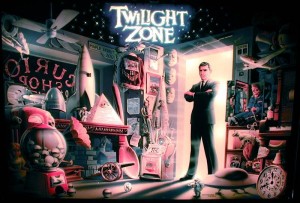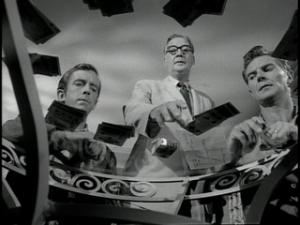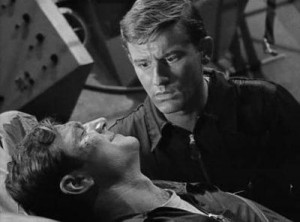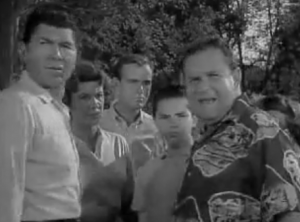 We continue with our series of posts by Arlen Schumer exploring The Twilight Zone. (Part 1 can be read here and Part 2 here.) In Part 3, Schumer continues his exploration of themes of the series, including “suburban nightmares,” and “science & superstition”:
We continue with our series of posts by Arlen Schumer exploring The Twilight Zone. (Part 1 can be read here and Part 2 here.) In Part 3, Schumer continues his exploration of themes of the series, including “suburban nightmares,” and “science & superstition”:
SUBURBAN NIGHTMARES
“It was the ‘twilight zone’ of the American culture. It was not English or Japanese or German or anything. It’s our Twilight Zone.” —Richard Matheson, 1989
“The Twilight Zone doesn’t only belong to a brief but distinctive epoch in our recent past—it could almost provide that period with a name,” wrote Village Voice film critic J. Hoberman in 1990. “The Twilight Zone defined the shadowy transition between the Fabulous Fifties and the Psychedelic Sixties. The show’s span encompassed the birth of the Space Race, the flowering of the Civil Rights Movement, and the life and death of the New Frontier…as the aspirin-ad angst music, op art patterns and beatnik bongos of the series’ celebrated credit sequence suggest, this historical twilight zone was a time of affluence and anxiety, of suave hysteria with a continual backbeat of crisis.”
Echoed Jonathan (Fortress of Solitude) Lethem, writing about Serling on the online magazine Gadfly in 1999, “Just the titles of his best episodes read like a found poem of All- American dread: Where Is Everybody? Walking Distance. People Are Alike All Over. Time Enough At Last. The Obsolete Man. The Eye of the Beholder. Nervous Man in a Four-Dollar Room. The Monsters Are Due on Maple Street…”
This acute ability by Serling to identify both primal and post-war American fears and crises, then build stories around them, set in commonplace surroundings—a psycho-American Gothic of sorts——was perhaps the single factor most responsible for the success and longevity of The Twilight Zone.
In “Third From the Sun,” Serling zeroed in on the greatest post-war fear, the threat of nuclear war. While it well-predated the October ’62 Cuban Missile Crisis, “Third…” uncannily captured the same armageddon zeitgeist in the nuclear air, as when the teenage daughter of the scientist protagonist (Fritz Weaver, who’s plotting with his test-pilot neighbor to leave the planet with their families before the bombs drop) anxiously murmurs, “Everyone I’ve talked to lately, they’ve been noticing it; that something’s wrong; that something’s in the air; that something’s going to happen—and everybody’s afraid…”
Based on Matheson’s short story, “Third…” also offered a prescient description of what the military-industrial complex would (ironically?) call M.A.D. (Mutually Assured Destruction):
 “Talk is 48 hours…48 hours, we’ll have them aloft…then whoosh, up, over and whammo! There goes the enemy! Obliterated—finished. And what are they doing in the meantime? Probably retaliating the best way they can. It’s a waste of time, let me tell you. We get the first licks, so they can’t do much…instead of losing 50 million people, we lose only 35…” The episode’s out-of-left-field twist- ending, in which the planet being emigrated to turns out to be earth, third from our sun, King noted, “…marks the point at which many occasional Twilight Zone tuners-in became addicts.”
“Talk is 48 hours…48 hours, we’ll have them aloft…then whoosh, up, over and whammo! There goes the enemy! Obliterated—finished. And what are they doing in the meantime? Probably retaliating the best way they can. It’s a waste of time, let me tell you. We get the first licks, so they can’t do much…instead of losing 50 million people, we lose only 35…” The episode’s out-of-left-field twist- ending, in which the planet being emigrated to turns out to be earth, third from our sun, King noted, “…marks the point at which many occasional Twilight Zone tuners-in became addicts.”
Recurring nightmares that seem more real than awakened reality are the stuff of Serling’s “Twenty-Two” (based on an anecdote in Bennett Cerf’s Famous Ghost Stories) and Charles Beaumont’s “Perchance to Dream.”
The circus and roller coaster dream sequences in “Perchance…” (“It was the kind of place you see only in nightmares—everything warped and twisted out of shape—but it was real, too”), and the initial descent into Room #22, the hospital morgue, are among the most visceral Twilight Zone scenes ever filmed (“Twenty-Two”’s even more, as it was shot on videotape, one of six Season 2 episodes taped in a cost-cutting experiment that produced shows of somewhat negligible quality).
Both episodes feature women in peculiarly powerful, secondary roles that remain mysteriously memorable and utterly modern in tone. In “Perchance…,” Suzanne Lloyd plays the mesmerizing “Maya, the Cat-Girl,” a raven-haired, leopard-skin-clad vixen who tempts Richard Conte’s latent libido—in his nightmare—by dancing an overtly sexual tarantella (especially for ‘59 TV) at the Tunnel of Love, beckoning Conte inside with “…her dark…cat’s…eyes!” In “Twenty-Two,” Arline Sax is the morgue nurse who recites her malevolent mantra, “Room for one more, honey,” with a Mona Lisa-like smile and devilish demeanor that is both strangely alluring and utterly repellent—a true Angel of Death.
Serling’s “The Hitch-Hiker” (based on a radio play by Lucille Fletcher, of the classic “Sorry, Wrong Number”) plays on the fear of picking one up, utilizing the shopworn character device of “Mr. Death,” but with a redeeming Twilight Zone fillip, as a “drab, little nothing of a man” plays off against ‘60s beauty Inger Stevens, in the first of her two nuanced Twilight Zone performances.
 The Swedish-born Stevens had “…a sadness hidden in that pretty face” (Bruce Springsteen, “Candy’s Room”), her sorrowful eyes betraying her failed suicide in 1959, while foreshadowing her unfortunate, successful attempt in 1970, giving “The Hitch-Hiker”— in which we, and Stevens’ character, come to realize she has been dead all along (shades of Shyamalan!)—a melancholy subtext, much like Douglas Trumbull’s Brainstorm had in 1983, released not long after the sudden death of star Natalie Wood.
The Swedish-born Stevens had “…a sadness hidden in that pretty face” (Bruce Springsteen, “Candy’s Room”), her sorrowful eyes betraying her failed suicide in 1959, while foreshadowing her unfortunate, successful attempt in 1970, giving “The Hitch-Hiker”— in which we, and Stevens’ character, come to realize she has been dead all along (shades of Shyamalan!)—a melancholy subtext, much like Douglas Trumbull’s Brainstorm had in 1983, released not long after the sudden death of star Natalie Wood.
Serling featured a startling number of independent women like Stevens in dramatic starring roles on The Twilight Zone, unheard of at a time when most women pictured on American television were either tame housewives or screwball comediennes (or, in the case of Lucille Ball, both).
On a par with Steven’s “Hitch-Hiker” performance is Anne Francis’ in “The After Hours,” because her casting, as a woman who turns out to be a mannequin, is perfect—she actually looks like a human Barbie doll (which, like The Twilight Zone, debuted in 1959 and became an American pop icon overnight, acknowledged as an influence on the plethora of TZ mannequin/doll/dummy episodes by Barbie Bazaar magazine, in its June 2003 issue: “The reason that Twilight Zone still amazes us is the wonder that underlies episodes like ‘The After Hours,’ that recall childhood fantasies of dolls and toys coming to life when no one is watching.”) And childhood nightmares, too—witness the whispering of the store mannequins, en masse, “Marsha, come off it!” to a frantic Francis.
“The After Hours” is one of Serling’s most accessible Twilight Zones—for who has never been afraid of being locked in a department store at night? By tapping into such deep-seated American neuroses, Serling mirrored the anxieties and apprehensions of his audience, as this excerpt from the episode’s closing narration testifies: “Just how normal are we? Just who are the people we nod our hellos to as we pass on the street?”
SCIENCE & SUPERSTITION
Rod Serling’s attitude toward the Space Race of The Sixties was evident in The Twilight Zone’s science fiction episodes: space ships usually never reach their destinations, or crash land if they do. By failing to solve our moral and ethical problems here on earth, Serling implied in first-season episodes like “I Shot an Arrow Into the Air” and “People Are Alike All Over,” we’ll never get to where we want to go— anticipating the platform of all anti-space advocates since. The chain of compromises and human failings that led to the 1986 Challenger shuttle disaster proved the relevancy of Serling’s warnings.
Serling utilized the science fiction genre as a front for his more personal, serious themes (much as Roddenberry would later do in Star Trek) in episodes like “People…,” writing against prejudice and racism on earth/America thinly disguised as a plea for interplanetary understanding, when an astronaut, crash-landed on Mars, speaks, with his dying breath, Serling’s best poetic dialogue:
 ”People are alike all over/I’m sure that when God made human beings/He developed them from a fixed formula/As long as they’ve got minds and hearts/That means they have souls That makes them people And people are alike.”
”People are alike all over/I’m sure that when God made human beings/He developed them from a fixed formula/As long as they’ve got minds and hearts/That means they have souls That makes them people And people are alike.”
His surviving astronaut partner does find out, to his chagrin, that people, whether on earth or other planets, were indeed alike, in their capacity for evil as well as good.
One of the greatest endings in modern movie history—the Statue of Liberty scene that concludes 1968’s Planet of The Apes—most are unaware of was the creation of Serling, (who co-wrote the screen adaptation), a big-screen revamp of his own Zone episode, “I Shot An Arrow In to the Air,” in which an astronaut, crash-landed on a desert planet, discovers—after murdering his two crewmen—that he’s been on earth the whole time, foreshadowed by his murdered crewman’s telephone pole-scrawl in the sand (suggested by an acquaintance of Serling’s at a cocktail party!).
1968’s other sci-fi masterpiece, Kubrick’s 2001: A Space Odyssey, contained numerous Twilight Zone tropes, from the robot HAL’s autonomy (e.g., “The Lonely”) to the film’s spaceship-in-baroque penultimate scene, as surreal a juxtaposition between future and past as the second-season Twilight Zone episode, “The Invaders,” that preceded it by seven years.
Agnes Moorehead’s dialogueless, mimetic performance as a farmwoman terrorized by tiny, mysterious figures, is a tour de force; according to director Doug Heyes, she had actually studied with the legendary mime Marcel Marceau years earlier.
Writer Richard Matheson later remade the episode as “Amelia,” part of a 1975 made-for-TV movie, Trilogy of Terror, starring Karen Black (fresh from her star turn in the film sequel Airport ’75) being chased around her New York City apartment by a truly frightening, knife-wielding “Zuni fetish doll,” Matheson’s substitute for the mini-Michelin Man-like astronauts he was never happy with fourteen years earlier.
 Serling’s first-season “The Monsters Are Due on Maple Street” details aliens’ deceptive manipulations of earthmen’s fear and greed to further their conquest, but, like most Twilight Zones, not in the way you expect them to. Following mysterious blackouts of electricity on their block, once-friendly neighbors unravel into an animalistic mob, and ast he sun falls, the episode becomes a kind of proto-Night of The Living Dead as they metaphorically eat each other alive—an equally-scabrous indictment of paranoid McCarthyism, the epitome of the “we have met the enemy and they are us” approach: “They pick the most dangerous enemy they can find, and it’s themselves,” Serling concludes, and speaking for the invading aliens as well as the Twilight Zone viewing audience, “All we need to do is sit back and watch.”
Serling’s first-season “The Monsters Are Due on Maple Street” details aliens’ deceptive manipulations of earthmen’s fear and greed to further their conquest, but, like most Twilight Zones, not in the way you expect them to. Following mysterious blackouts of electricity on their block, once-friendly neighbors unravel into an animalistic mob, and ast he sun falls, the episode becomes a kind of proto-Night of The Living Dead as they metaphorically eat each other alive—an equally-scabrous indictment of paranoid McCarthyism, the epitome of the “we have met the enemy and they are us” approach: “They pick the most dangerous enemy they can find, and it’s themselves,” Serling concludes, and speaking for the invading aliens as well as the Twilight Zone viewing audience, “All we need to do is sit back and watch.”
In Part 4 of this series Schumer will continue to explore the themes of The Twilight Zone, picking up the discussion with consideration of “The Time Element,” and Obsolete Man.”
Arlen Schumer wrote and designed Visions From The Twilight Zone, the only coffee table art book about the series, and continues to present a multimedia show based on the book to universities and cultural institutions around the country, including The 2008 Rod Serling Conference at Ithaca University, and the 2009 New York Comic Convention, where he also presented his mini-marathon, “The Five Themes of The Twilight Zone.” He presented his new show, “The Twilight Zone Forever,” at The New York Times’ TimesCenter in New York on the exact 50th Anniversary of The Twilight Zone’s debut, October 2, 2009. On November 11 Schumer will make a presentation in connection with a screening the 50th anniversary of “The Eye of the Beholder” episode at the prestigious Tribeca Cinema. Tickets can be purchased here
The Twilight Zone season 1 & season 2 are available on Blu-ray DVD at the TheoFantastique Store.





2 Responses to “THE TWILIGHT ZONE FOREVER: On the release of Rod Serling’s The Twilight Zone Seasons 1 & 2 on Blu-ray (Part 3)”